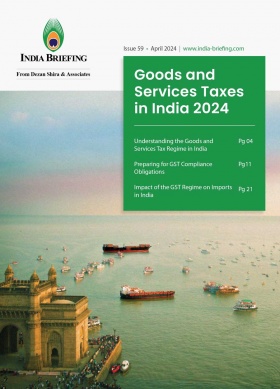India’s Electronics Exports to Hit US$61 Billion by 2030
A pick up in global demand and expanding domestic production are driving India’s electronics industry. The country intends to produce US$300 billion worth of electronics by the fiscal year 2026, which will increase demand for semiconductors worth between US$90 and US$100 billion, creating a window of opportunity for local players.
In FY 2023-24, electronics exports from India surpassed the US$20-billion-mark, demonstrating the country’s increasing competitiveness.
This accomplishment opens the door for additional research into export prospects while showcasing India’s expertise in electronics production. India’s exports of electronic goods rose from INR 200.97 billion (approx. US$2.41 billion) in January 2024 to INR 248.72 billion (approx. US$2.99 billion) in the following month.
The annual export value of top-performing industries, such as engineering goods, electronics goods, and pharmaceuticals and drugs, increased in FY’24, a year in which geopolitical tensions drove up energy prices and high interest rates worldwide reduced demand.
Read: Import and Export Procedures in India
Electronic goods exported from India
As per the latest research conducted by a global research agency, the electronics industry in the domestic market is predicted to develop at the highest pace among all segments. India’s export value is estimated to nearly triple to US$835 billion by 2030, from US$431 billion in 2023, at a compound annual growth (CAGR) rate of 24 percent. Exports of electronics is anticipated to rise from US$28 billion in 2023 to US$61 billion in 2030, a more than twofold increase.
Companies based in the U.S. make up the majority of investors in India, particularly in the electronics industry. East Asia majors—Japan and South Korea—are also making significant investments in India’s electronics, automotive, and consumer durable industries to capitalize on its expanding domestic market and competitive labor costs.
India is a global exporter of a broad variety of electronic items. The following are a few of the main electronics that India exports:
- Mobile phones: India is the world’s second-largest manufacturer of mobile phones.
- Computer hardware: India exports a sizable quantity of computer hardware, such as motherboards, CPUs, and laptops.
- Consumer electronics: Televisions, refrigerators, and washing machines are just a few of the items that the nation exports in large quantities.
- Electronic components: India exports components including resistors, capacitors, and semiconductors.
- Medical electronics: India exports medical equipment, such as blood glucose monitors, X-ray machines, and ultrasound machines.
India’s electronics sector is expanding quickly, propelled by big objectives and a calculated plan to take the lead globally. With a strong emphasis on exports, India hopes to produce an astounding US$300 billion worth of electronics, backed by different central government policies and schemes.
Accelerating growth of electronics sectors
Within nine months of FY 2023-24, electronics exports from India surpassed US$20 billion, demonstrating the country’s increasing competitiveness and potential in the global economy. This accomplishment opens the door for additional investigation into export prospects while showcasing India’s expertise in electronics production.
|
Commodity |
Trade |
April 2023 |
April 2024 |
Growth % |
|
Electronic Goods
|
Export |
2107.61 |
2651.32 |
25.80 |
|
Import |
6408.41 |
7051.26 |
10.03 |
Source: PIB
The rise in electronics exports boosts India’s economy by substantially increasing foreign exchange inflows. The sector’s involvement in India’s growing trajectory is highlighted by the importance of electronics exports as the country works towards its aim of ranking among the top global economies.
The increase in electronics exports is significantly boosting India’s economy by enhancing foreign exchange inflows. This sector’s contribution is crucial to India’s economic growth, supporting the nation’s goal of becoming one of the top global economies.
Electronic integrated circuits and micro-assembly: Top 10 export markets for India
|
S.no. |
Country / region |
Values in US$ million (FY2023-24) |
|
1 |
Hong Kong |
56.70 |
|
2 |
South Korea |
39.12 |
|
3 |
Vietnam |
29.21 |
|
4 |
U.S. |
13.43 |
|
5 |
Russia |
11.13 |
|
6 |
China |
10.18 |
|
7 |
Singapore |
8.68 |
|
8 |
UAE |
6.75 |
|
9 |
Ireland |
6.04 |
|
10 |
Finland |
5.18 |
Source: Department of Commerce, GoI
India’s two largest export markets for electrical goods are the U.S. and the United Arab Emirates (UAE). In FY’24, about one-third of India’s US$8.7 billion in electronic goods exports went to the U.S. in February. The UAE came in second at US$3 billion (12 percent). The U.K. and the Netherlands each had a stake of roughly five percent.
Emerging export-oriented production bases in India
In April 2024, it was announced that Tamil Nadu, in southern India, had become the country’s top exporter of electronic goods—which accounted for about 30 percent of all goods manufactured for export from the state (FY 2023-24). Till FY 2021-22, states like Karnataka and Uttar Pradesh had dominated the export of electronic goods from India.
Over the past two fiscal years, nearly 40 percent of smartphones in India were exported from Kancheepuram, a district in the north-eastern region of Tamil Nadu, per a report in The Hindu. The majority of these were headed to the U.S., UAE, and Netherlands.
Tamil Nadu exported electronic items valued at over US$7.4 billion between April 2023 and January 2024—nearly four times its FY 2021-22 volume.
Policy intervention and key schemes
Keeping in view India’s year-on-year performance of electronic goods exports, the central government announced its National Policy for Electronics (NPE) in 2019. NPE was founded to turn the country into a comprehensive hub for Electronics System Design and Manufacturing (ESDM) by fostering an environment that allows the industry to compete with its global counterparts. Furthermore, the ESDM sector is one of the top 25 priority industries in the government’s Made in India initiative, making it a crucial engine of economic expansion.
India has several national-level schemes in place for electronics manufacturing and assembly, namely the Production-Linked Incentive Scheme (PLI), the Scheme for Promotion of Manufacturing of Electronic Components and Semiconductors (SPECS), and the Modified Electronics Manufacturing Clusters Scheme (EMC 2.0). These three schemes were notified in April 2020. A fourth scheme, namely the Production-Linked Incentive Scheme (PLI) for IT Hardware, was notified in March 2021.
Global challenges threaten India’s export performance
The think tank, Global Trade Research Initiative (GTRI), noted in a recent report that global events had had an impact on India’s trade performance in 2024. Factors that could dent India’s export performance include the EU’s proposed carbon tax and forest regulations; the ongoing Russia-Ukraine war; costlier crude oil due to the tensions in US-China trade; and Houthi attacks on ships navigating the Red Sea which have resulted in increased freight costs and disruptions to supply chains.
Experts anticipate further growth in export-oriented industries, such as electronics, mobile manufacturing, medicines, and drugs, with the numbers showing how India is beating a slowdown in general global trade trends. Nevertheless, there is a growing fear of protectionism among developed economies that could temper the pace of future export growth and unfettered access to high value markets.
Several emerging economies like Vietnam and Malaysia are also attempting to strengthen their domestic manufacturing environment, update industrial policies, and address labor standards and supply chain due diligence laws, which will increase competition for India.
In turn, India has set localization riders in its investment incentives policies—aiming to reduce component import dependency from markets like China and Southeast Asia. The country also has a larger trainable workforce and availability of key resources for large scale production, as seen in the case of Tamil Nadu’s growing profile in global supply chains.
Key takeaways
- India’s month-on-month growth in exports of electronic goods rose to INR 248.72 billion (US$2.99 billion) in February 2024. Over the course of nine months in FY2023-24, the sector’s exports have reportedly surpassed US$20 billion.
- FY’24 has been positive for India’s overall export size; the country’s electronics exports are expected to rise to US$61 billion in 2030.
- Multinational firms, in particular, U.S.-based companies, are increasingly investing in India’s electronics industry. Meanwhile, Japan and Korea are also investing in India’s electronics, automotive, and consumer durable industries.
- Export data indicates that the U.S. and UAE are two of the largest markets for Indian electronic goods, with significant exports also going to the U.K. and the Netherlands.
- Recent global events have impacted India’s trade numbers.
(US$1 = INR 83.15)
About Us
India Briefing is one of five regional publications under the Asia Briefing brand. It is supported by Dezan Shira & Associates, a pan-Asia, multi-disciplinary professional services firm that assists foreign investors throughout Asia, including through offices in Delhi, Mumbai, and Bengaluru in India. Readers may write to india@dezshira.com for support on doing business in India. For a complimentary subscription to India Briefing’s content products, please click here.
Dezan Shira & Associates also maintains offices or has alliance partners assisting foreign investors in China, Hong Kong SAR, Dubai (UAE), Indonesia, Singapore, Vietnam, Philippines, Malaysia, Thailand, Bangladesh, Italy, Germany, the United States, and Australia.
- Previous Article IT Industry Embraces Tier 2 Cities for Growth and Efficiency
- Next Article Leave Management in India: Key Considerations for Employers and Employees









